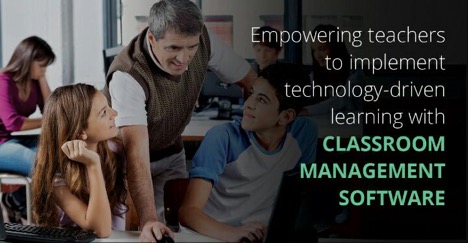Description: Today’s digital classrooms pose multi-dimensional challenges for teachers, rendering their lessons and instructions less effective. These issues can be resolved with the help of a classroom management software, which has the proven capability to empower teachers in the technology-driven education landscape.
In December 2018, CNN posted a feature citing an American couple who had moved to Germany when their daughter was a toddler and returned when she had turned a fourth grader. She got enrolled in the fourth grade of a school in San Francisco Bay Area, California. There, she was the only child in her class who did not have a smartphone.
That is how early the children get to own a gadget today. It also indicates the extent of children’s exposure to technology in this era. Keeping up with the youngsters’ proclivities, education institutes have been actively incorporating technology to make learning as interesting and engaging as their off-campus experiences.
Diverse Challenges for 21st-Century Teachers
Unarguably, digital classrooms and smart laboratories have transformed the way knowledge is imparted today. However, this paradigm shift has a fair share of cons along with its pros. For instance, the access to computers and/or mobile devices inside the classroom or the campus proves to be a distraction for the students. They tend to deviate from the on-going session and indulge in chatting, games, and other undesired activities. With increasing number of institutes providing one-to-one computer access to students, it has become nearly impossible for teachers to monitor every pupil in the classroom.
Education institutes are also rapidly replacing pen and papers with computers for students’ aptitude assessment. While IT staff is tasked to create a fool-proof examination environment, the classroom instructors still remain under mounting pressure to ensure strict invigilation. In short, teachers have a fairly taxing experience as a result of the rapid adoption of technology by education institutes.
Interestingly, teachers are rather enthusiastic about leveraging technological innovations to enhance the learning experience. According to a survey, more than 80% of teachers agree that technology in the classroom enables students to get more hands-on experience during the lessons. However, less than 40% of them expressed willingness to use digital technology in the classroom, and they have legitimate concerns.
Teachers have to stay versed in technology-driven trends but the rapid advancements in the IT and the complexity it entails makes it difficult to stay updated. Inadequate training on how to use technology in the classroom is another issue, with more than 91% of teachers citing it as a concern. Lack of skill-development facilities, where they can access the resources that are restricted in the classroom, also adds to their woes. Therefore, teachers need innovative digital tools that are easy-to-use, requires almost no training, and can empower them to manage the entire classroom with greater authority and control.
The Solution
From elementary schools to universities, institutes are opting for classroom computer management software to address the common classroom management challenges faced by teachers. These solutions are purpose-built to simplify the task of instructors and enable institutes to realize the intended purpose of education technology. However, given the situation of the teachers, deployment of a classroom management software may seem to compound their problems further. Highlighting the capabilities of these tools is, therefore, crucial to building confidence in all the stakeholders. It also helps in gauging the effectiveness of such a solution post-deployment.
How A Class Control Software Helps in Managing Digital Classrooms
A good classroom computer management solution has extended functionality ranging from monitoring students’ computers to simplifying instructors’ chores. A classroom management software is helpful in the following ways:
Remote Control: Teachers can view and control each student’s device from the software dashboard. This helps in monitoring as well as assisting pupils when they get stuck on a task. For instance, if a student could not hear an instruction clearly and is on the wrong lesson or exercise, the instructor can remotely access their device to assist. Similarly, teachers can also disable students’ mouse and keyboards, or blackout their screens, if needed.

Internet/Application Restrictions: A classroom computer management software provides single-point control to instructors for blocking or restricting specific websites, domains, applications, or resources. Teachers can even control the network connectivity of students’ devices with the help of such a software.
Shared Learning: A classroom management software promotes collaboration and improves the student-teacher relationship. The screen sharing feature of the software allows instructors to display their screen on students’ devices. This facilitates one-to-one attention to each pupil while teachers do not have to physically visit each child’s desk. If a child solves a problem correctly, instructors can share his/her screen with the rest of the class. This can act as an appreciation for the one who completed the task and motivates the rest to keep up.
Enhanced Interaction: A comprehensive class control software supports various modes of communication such as chat, broadcast, and audio. This provides the liberty to instructors to experiment with the way the class is conducted and analyze students’ response. They can use these features to make their lessons more impactful and interesting. It also improves student-teacher interaction as these means of communication are more relatable for students in this age of social media.
Assessments and Exercises: Using a classroom management software, teachers can easily prepare quizzes, polls, exercises, examination questions, and more. They can also evaluate the answers/responses and generate results accordingly. A class control software also empowers instructors to set the devices in assessment mode without any technical assistance. It relieves them of the hassle of invigilation, yet ensures secure examination environment.
The Effectiveness of Classroom Management Software
A classroom management software can empower teachers to control the devices of the students as per the academic requirement. Further, the reach of this powerful classroom management tool extends to the students as well. With the right websites and applications in hand, students can learn in a free and open classroom environment, without any distractions of the internet. For instance, a community college in Illinois with 2,000 workstations across multiple computer labs faced issues in keeping students focused on the lesson. Students frequently surfed the Internet instead of paying attention to the course material. Their inhibition to ask questions during sessions was another problem. The college administration resorted to class control software, which eased the instructor’s job and enabled them to restrict students from surfing the Internet or otherwise disrupting the instructions. Students can now learn by raising questions directly to the teachers, who could address it without disturbing other pupils in the classroom.
Likewise, numerous education institutes have deployed popular class control software solutions like Faronics Insight to empower instructors for technology-driven teaching. Presently, deploying a classroom management software is the simplest and the most effective way for teachers to control students in-session activities.

